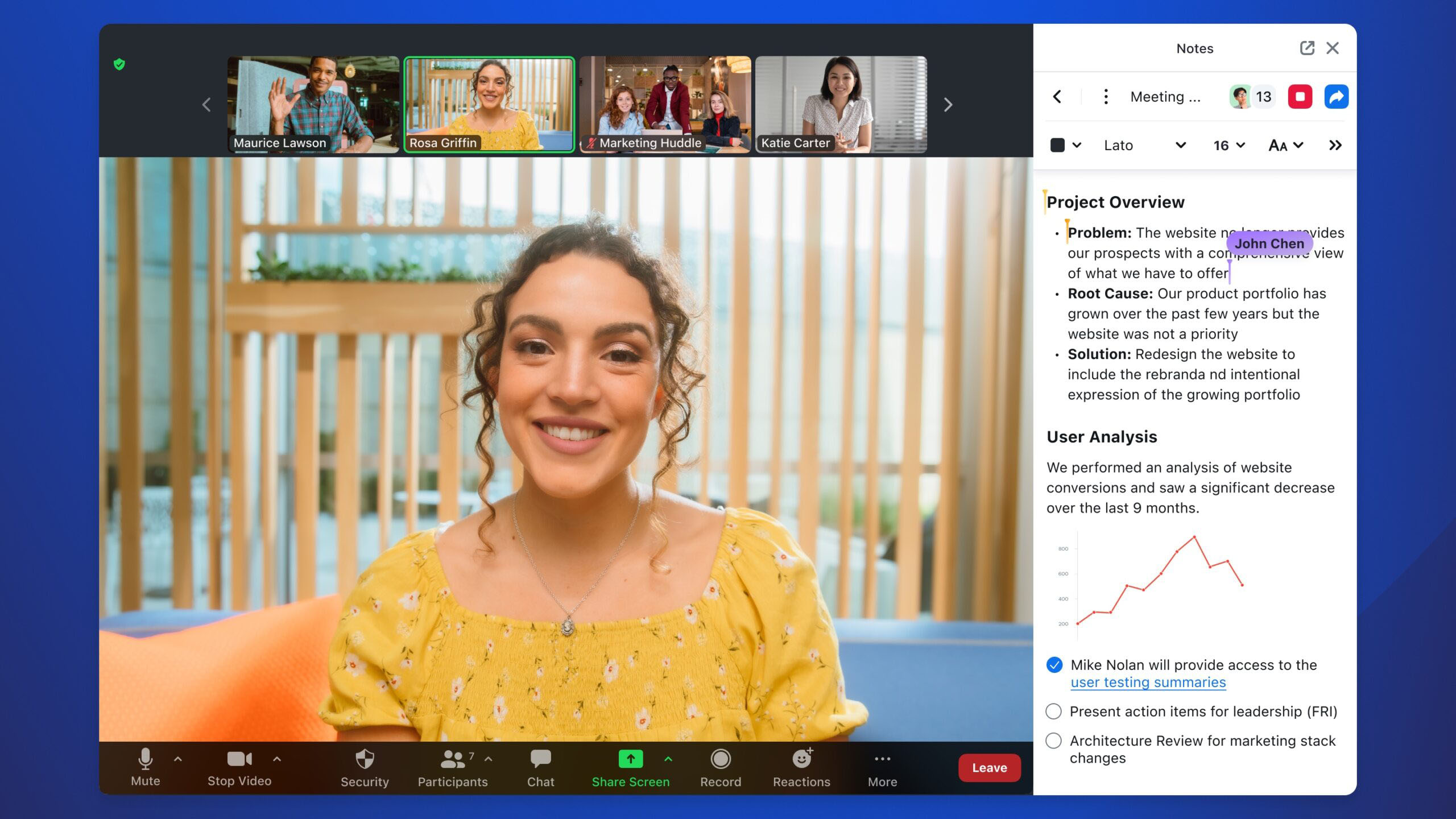Sponsored by Google Workspace
5 mistakes businesses make when choosing a virtual meeting platform
Don't make these mistakes when selecting your company's virtual meeting platform

The business world has undergone a complete transformation thanks to technology, and virtual meetings now lead this change.
The necessity for virtual meetings has become essential because they maintain continuous communication while strengthening teamwork and preserving company spirit.
Teams can maintain their connection and accomplish their goals through these online meetings, which operate without geographical limitations.
The numerous virtual meeting platforms and video conferencing software available create a complex situation when selecting the most suitable platform. The search for the right solution becomes as challenging as searching for a needle in a haystack.
The wrong choice of tool creates communication problems, employee stress, and security risks, which negatively affect both productivity and financial performance.
This article examines five common errors organizations make when selecting virtual meeting platforms , providing practical advice for better decision-making. Your upcoming virtual meeting should run smoothly.
Your Complete Productivity Suite. Email, Docs, Meetings, and AI in One Place. Upgrade to Google Workspace and save 15% on Starter, Standard and Plus for 12 months (Flex & Commit).
Techradar Pro Approved Sponsored Offer
1. Not assessing your specific needs thoroughly
A common mistake businesses make is jumping into choosing a platform without fully understanding what they actually need. A "one-size-fits-all" approach rarely works when it comes to communication tools.
Not defining the meeting purpose
Different types of virtual meetings require different features. A quick team check-in has very different needs compared to a large webinar for dozens of external guests or a sensitive client demo that needs great screen-sharing and annotation tools.
If you don’t clearly outline the purpose of your virtual meetings first, you might end up with a platform that’s either too complex and expensive or lacking in critical features your team needs. This confusion often leads to mismatched functions and frustrated users.
Ignoring audience size and tech capabilities
Another significant mistake is not accurately estimating the number of people who will be involved in your meetings. Underestimating the need for scalability—such as the number of participants that can join simultaneously—can cause crashes, lag, and an unprofessional experience.
Additionally, it’s essential to consider the technical capabilities and internet reliability of both your internal teams and external participants. If a platform requires a significant amount of bandwidth, it may not be accessible to everyone, thereby limiting engagement.

Neglecting essential features and integrations
Many businesses overlook the importance of listing essential features they can’t do without. This should cover basic needs, such as reliable screen sharing, meeting recording, and chat options, alongside more advanced features like breakout rooms for small group discussions, polling tools for audience interaction, and Q&A options for larger presentations.
Also, don’t forget to check if the platform can integrate smoothly with your existing tools—such as your CRM, calendars, and project management apps—because failing to do so can slow down workflows and create data gaps, making collaboration more difficult.
2. Overlooking ease of use and the user experience (UX)
Even the most feature-rich platform is useless if your team struggles to use it. Businesses often prioritize an exhaustive list of features over the actual user experience.
Don't forget about simplicity
The promise of exciting platform features creates an overwhelming desire to join. Everyone wants access to the most recent technological advancements. The numerous features that platforms offer can transform into an overwhelming and complex system.
The majority of users will abandon a platform when it requires advanced knowledge. Your goal should be an interface that guides users directly into the platform without leading them through complex menu systems. The platform's simple design and user-friendly controls enable users to maintain their attention on meeting content instead of struggling with technology.
The training app
Have you ever thought that your team would just magically know how to use a new virtual meeting platform? The chances are slim that this will happen. The decision to skip proper training and onboarding procedures will result in significant financial losses.
Users who lack helpful tutorials and guidance will likely only experience basic platform functions or become frustrated with everyday operations. Training functions as an investment that generates returns by making your team proficient users, while preventing technology-related meeting mishaps.

Don't overlook accessibility
The absence of accessibility features in modern workplaces creates two major problems: it produces missed opportunities alongside serious issues. The features of closed captions, together with keyboard shortcuts and screen reader compatibility, serve as fundamental requirements.
The complete participation of all team members, particularly those with disabilities, remains essential for building an equitable and inclusive workplace environment. The absence of these features can lead to communication breakdowns and expose you to potential legal problems. The practice of accessibility enables your organization to welcome all participants who want to contribute.
3. Ignoring scalability and reliability
The virtual meeting platform you choose today must be able to meet your needs not just now, but also in the future. Failing to consider scalability and reliability can result in significant disruptions and unexpected costs.
Not planning for growth
After selecting a platform, businesses tend to focus on their immediate requirements without considering the inevitable growth that will occur. Your organization’s expanding workforce will create demands for increased meeting capacity, additional participants, and sophisticated platform capabilities.
Selecting a platform that lacks scalability capabilities will force you to migrate to a new system later, which results in wasted investments and operational challenges. The lack of scalability in your chosen platform may force you to switch to a different system, which causes both financial losses and system migration challenges.

Underestimating technical stability and uptime
The worst possible moment to experience connection drops and video and audio lag occurs during virtual meetings. The beginning of a meeting can transform into a technical disaster reality show.
Before making a decision, you should research your vendor’s reliability performance by examining their uptime statistics and their ability to manage high traffic volumes. Downtime results in business losses and time waste, which everyone wants to avoid.
Lack of redundancy and backup plans
A sudden crash of your primary virtual meeting platform requires a well-developed emergency response strategy. Many companies fail to consider this. A reliable platform needs to incorporate automatic backup systems that maintain continuous operation.
A backup plan that includes a secondary platform for essential meetings will protect you from complete system breakdowns when unexpected events occur. Your preparedness enables you to continue making progress, regardless of the situation.
4. Neglecting security and privacy measures
In an era of increasing cyber threats and stringent data protection regulations, overlooking the security and privacy aspects of a virtual meeting platform is a significant and potentially damaging mistake.
Neglecting data safety
During virtual meetings, you expose sensitive information, which includes trade secrets, strategic game plans, and client data. Using a platform without robust security features creates a dangerous situation.
Your selection of a meeting tool must include top-notch data protection through end-to-end encryption. The encryption system protects your discussions and shared files from unauthorized access while keeping them securely encrypted.
Overlooking compliance
The location of your business and its industry sector determine which data privacy laws you must follow, such as HIPAA for healthcare and GDPR for European operations.
Using a meeting platform that fails to follow rules will result in both financial penalties and damage to your organization's reputation. The research you conduct in this field stands as an absolute necessity.

Weak access controls
The “meeting bombing” incident demonstrated how unsecured access controls can create complete chaos. The incident highlighted the dangers of inadequate access controls.
Your meetings become vulnerable to unauthorized visitors when you use platforms that lack features such as waiting rooms, password protection, two-factor authentication, and strict permission settings. Your discussions, which involve confidential information, require robust access controls to protect them from unauthorized access.
5. Disregarding vendor support and training infrastructure
The relationship with your virtual meeting platform provider extends beyond the initial purchase. The quality of vendor support and the availability of ongoing resources are critical for long-term success.
Don't sleep on customer support quality
Technical problems are inevitable, so you need excellent customer support to help you navigate these situations. A slow or unreachable support team on your platform will leave you in a difficult situation during meetings, resulting in both frustration and wasted time. Check the available contact methods (phone, chat, or email) along with response times and support hours for your team.
Skipping out on training resources
The onboarding celebration ends, but what follows next? Your team will fail to explore all the capabilities of your platform because there is insufficient guidance through guides, video tutorials, and ongoing training materials.
The absence of simple help resources and new learning opportunities leads many fantastic features to remain unused. Your investment becomes useless while the system creates confusion for all users who try to use it.
Overlooking the vendor's future plans
The speed of technological advancement continues to accelerate while meeting platforms maintain their rapid pace. Selecting a platform that shows no signs of development or lacks future direction amounts to throwing away your investment funds.
A reliable vendor maintains continuous innovation by developing new features and enhancing existing ones, and maintaining strict security measures. A platform that focuses on progress will provide you with the most up-to-date tools, enabling you to stay ahead of the competition.
Final words
The shift to virtual meetings has become essential for communication and teamwork, regardless of location. However, selecting the right platform can be challenging, and mistakes can lead to communication issues, stress, security risks, and decreased productivity.
Common errors include failing to define the meeting’s purpose, ignoring audience size and technical capabilities, and overlooking important features and integrations.
Additionally, businesses often underestimate the importance of simplicity, training, and accessibility, which can lead to user frustration.
Planning for future growth is vital; without scalability, costly system migrations may be necessary. Neglecting technical stability, redundancy, and data safety can cause significant disruptions and expose sensitive information to risks and penalties.
Finally, the quality of vendor support and available training resources are crucial for long-term success and competitiveness.
Sign up to the TechRadar Pro newsletter to get all the top news, opinion, features and guidance your business needs to succeed!
Bryan M. Wolfe is a staff writer at TechRadar, iMore, and wherever Future can use him. Though his passion is Apple-based products, he doesn't have a problem using Windows and Android. Bryan's a single father of a 15-year-old daughter and a puppy, Isabelle. Thanks for reading!

